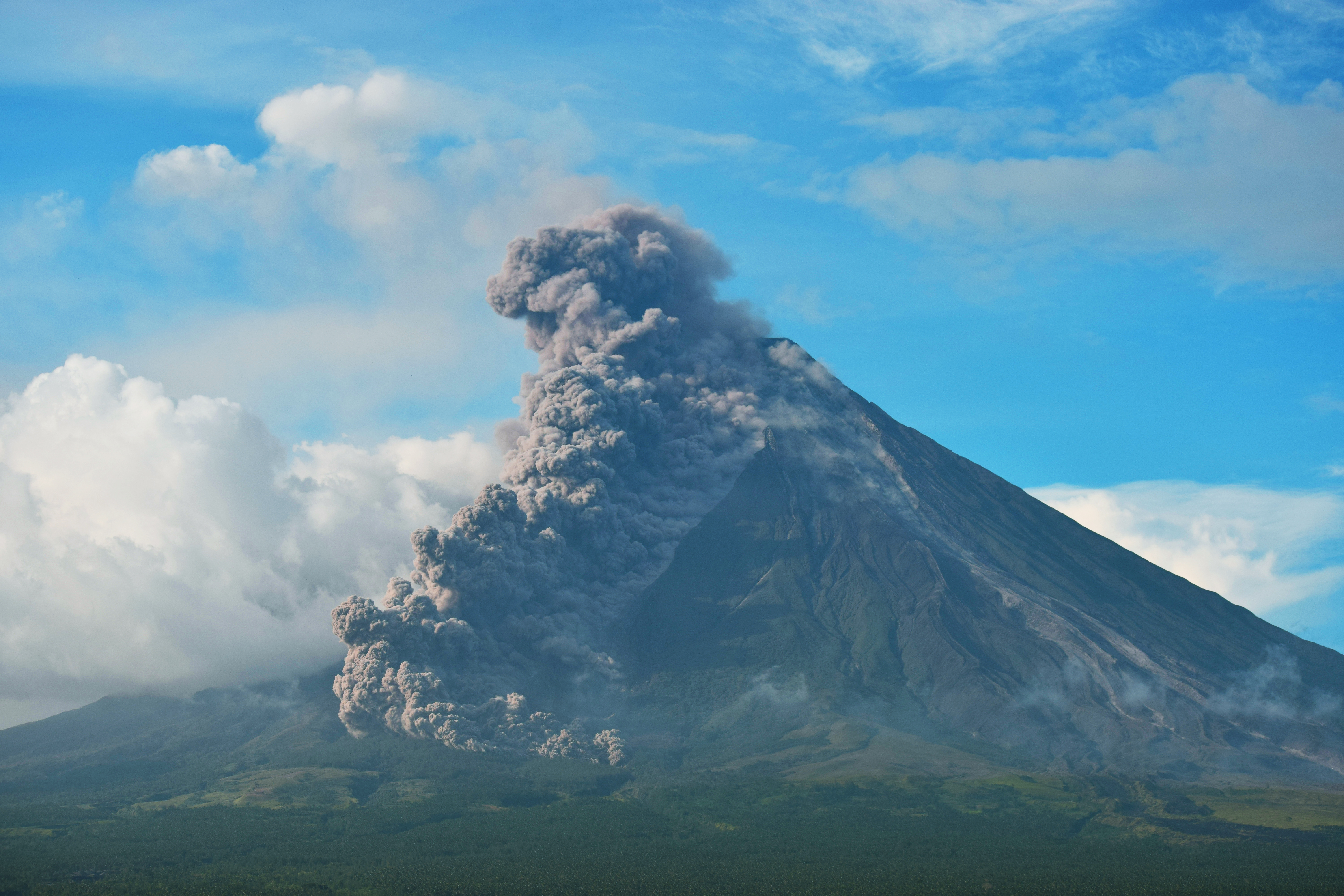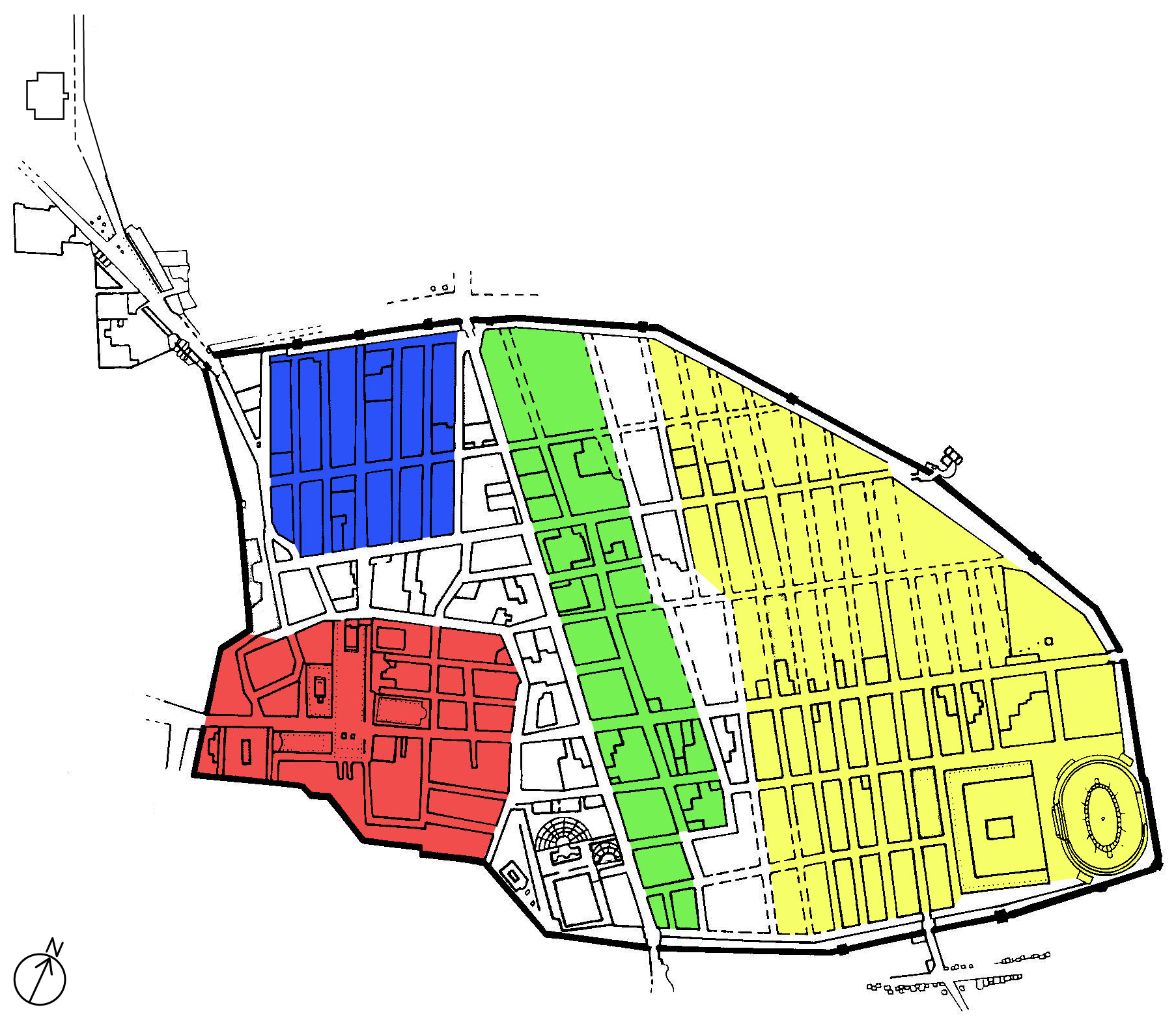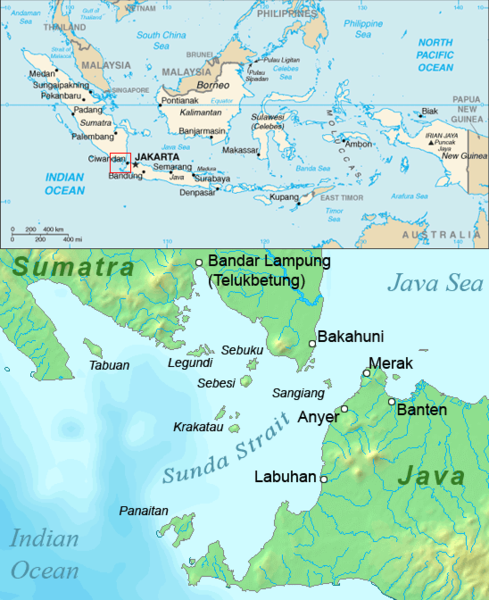|
Pyroclastic Fall
A pyroclastic fall deposit is a uniform deposit of material which has been ejected from a volcanic eruption or plume such as an ash fall or tuff. Pyroclastic fallout deposits are a result of: # Ballistic transport of ejecta such as volcanic blocks, volcanic bombs and lapilli from volcanic explosions # Deposition of material from convective clouds associated with pyroclastic flows such as coignimbrite falls # Ejecta carried in gas streaming from a vent. The material under the action of gravity will settle out from an eruption plume or eruption column #Ejecta settling from an eruptive plume or eruption column that is displaced laterally by wind currents and is dispersed over great distances Structures The deposits of pyroclastic falls follow a well sorted and well bedded trend. They exhibit mantle bedding—the deposits directly overlie pre-existing topography and maintain a uniform thickness over relatively short distances. Sorting by size is more pronounced than pyroclastic ... [...More Info...] [...Related Items...] OR: [Wikipedia] [Google] [Baidu] |
Volcanic Eruption
A volcanic eruption occurs when material is expelled from a volcanic vent or fissure. Several types of volcanic eruptions have been distinguished by volcanologists. These are often named after famous volcanoes where that type of behavior has been observed. Some volcanoes may exhibit only one characteristic type of eruption during a period of activity, while others may display an entire sequence of types all in one eruptive series. There are three main types of volcanic eruptions. Magmatic eruptions involve the decompression of gas within magma that propels it forward. Phreatic eruptions are driven by the superheating of steam due to the close proximity of magma. This type exhibits no magmatic release, instead causing the granulation of existing rock. Phreatomagmatic eruptions are driven by the direct interaction of magma and water, as opposed to phreatic eruptions, where no fresh magma reaches the surface. Within these broad eruptive types are several subtypes. The we ... [...More Info...] [...Related Items...] OR: [Wikipedia] [Google] [Baidu] |
Topographic Map
In modern mapping, a topographic map or topographic sheet is a type of map characterized by large- scale detail and quantitative representation of relief features, usually using contour lines (connecting points of equal elevation), but historically using a variety of methods. Traditional definitions require a topographic map to show both natural and artificial features. A topographic survey is typically based upon a systematic observation and published as a map series, made up of two or more map sheets that combine to form the whole map. A topographic map series uses a common specification that includes the range of cartographic symbols employed, as well as a standard geodetic framework that defines the map projection, coordinate system, ellipsoid and geodetic datum. Official topographic maps also adopt a national grid referencing system. Natural Resources Canada provides this description of topographic maps: Other authors define topographic maps by contrasting them with ... [...More Info...] [...Related Items...] OR: [Wikipedia] [Google] [Baidu] |
Pyroclastic Surge
A pyroclastic surge is a fluidised mass of turbulent gas and rock fragments that is ejected during some volcanic eruptions. It is similar to a pyroclastic flow but it has a lower density or contains a much higher ratio of gas to rock, which makes it more turbulent and allows it to rise over ridges and hills rather than always travel downhill as pyroclastic flows do. The speed of pyroclastic density currents has been measured directly via photography only in the case of Mount St. Helens, where they reached 320-470 km/h, or . Estimates of other modern eruptions are around 360 km/h, or 100 m/s (225 mph). Pyroclastic flows may generate surges. For example, the city of Saint-Pierre, Martinique, Saint-Pierre in Martinique in 1902 was overcome by one. Pyroclastic surge include 3 types, which are base surge, ash-cloud surge, and ground surge. Base surge Base surges were first recognized after the Taal Volcano eruption of 1965 in the Philippines, where a visiting vol ... [...More Info...] [...Related Items...] OR: [Wikipedia] [Google] [Baidu] |
Pyroclastic Rock
Pyroclastic rocks are clastic rocks composed of rock fragments produced and ejected by explosive volcanic eruptions. The individual rock fragments are known as pyroclasts. Pyroclastic rocks are a type of volcaniclastic deposit, which are deposits made predominantly of volcanic particles. 'Phreatic' pyroclastic deposits are a variety of pyroclastic rock that forms from volcanic steam explosions and they are entirely made of accidental clasts. 'Phreatomagmatic' pyroclastic deposits are formed from explosive interaction of magma with groundwater. The word ''pyroclastic'' is derived from the Greek , meaning fire; and , meaning broken. Unconsolidated accumulations of pyroclasts are described as tephra. Tephra may become lithified to a pyroclastic rock by cementation or chemical reactions as the result of the passage of hot gases (fumarolic alteration) or groundwater (e.g. hydrothermal alteration and diagenesis) and burial, or, if it is emplaced at temperatures so hot that the soft gla ... [...More Info...] [...Related Items...] OR: [Wikipedia] [Google] [Baidu] |
Pyroclastic Flow
A pyroclastic flow (also known as a pyroclastic density current or a pyroclastic cloud) is a fast-moving current of hot gas and volcanic matter (collectively known as tephra) that flows along the ground away from a volcano at average speeds of but is capable of reaching speeds up to . The gases and tephra can reach temperatures of about . Pyroclastic flows are the deadliest of all volcanic hazards and are produced as a result of certain explosive eruptions; they normally touch the ground and hurtle downhill or spread laterally under gravity. Their speed depends upon the density of the current, the volcanic output rate, and the gradient of the slope. Origin of term The word ''pyroclast'' is derived from the Greek (''pýr''), meaning "fire", and (''klastós''), meaning "broken in pieces". A name for pyroclastic flows that glow red in the dark is (French, "burning cloud"); this was notably used to describe the disastrous 1902 eruption of Mount Pelée on Martinique, a Frenc ... [...More Info...] [...Related Items...] OR: [Wikipedia] [Google] [Baidu] |
Pumice
Pumice (), called pumicite in its powdered or dust form, is a volcanic rock that consists of extremely vesicular rough-textured volcanic glass, which may or may not contain crystals. It is typically light-colored. Scoria is another vesicular volcanic rock that differs from pumice in having larger vesicles, thicker vesicle walls, and being dark colored and denser.Jackson, J.A., J. Mehl, and K. Neuendorf (2005) ''Glossary of Geology'' American Geological Institute, Alexandria, Virginia. 800 pp. McPhie, J., M. Doyle, and R. Allen (1993) ''Volcanic Textures A guide to the interpretation of textures in volcanic rocks'' Centre for Ore Deposit and Exploration Studies, University of Tasmania, Hobart, Tasmania..198 pp. Pumice is created when super-heated, highly pressurized rock is rapidly ejected from a volcano. The unusual foamy configuration of pumice happens because of simultaneous rapid cooling and rapid depressurization. The depressurization creates bubbles by lowering the sol ... [...More Info...] [...Related Items...] OR: [Wikipedia] [Google] [Baidu] |
Pompeii
Pompeii ( ; ) was a city in what is now the municipality of Pompei, near Naples, in the Campania region of Italy. Along with Herculaneum, Stabiae, and Villa Boscoreale, many surrounding villas, the city was buried under of volcanic ash and pumice in the eruption of Mount Vesuvius in 79 AD. Largely preserved under the ash, Pompeii offers a unique snapshot of Culture of ancient Rome, Roman life, frozen at the moment it was buried, as well as insight into ancient urban planning. It was a wealthy town of 10,000 to 20,000 residents at the time it was destroyed. It hosted many fine public buildings and luxurious private houses with lavish decorations, furnishings and artworks, which were the main attractions for early excavators; subsequent excavations have found hundreds of private homes and businesses reflecting various architectural styles and social classes, as well as numerous public buildings. Organic remains, including wooden objects and human bodies, were interred in the as ... [...More Info...] [...Related Items...] OR: [Wikipedia] [Google] [Baidu] |
Mount Vesuvius
Mount Vesuvius ( ) is a Somma volcano, somma–stratovolcano located on the Gulf of Naples in Campania, Italy, about east of Naples and a short distance from the shore. It is one of several volcanoes forming the Campanian volcanic arc. Vesuvius consists of a large volcanic cone, cone partially encircled by the steep rim of a summit caldera, resulting from the collapse of an earlier, much higher structure. The eruption of Mount Vesuvius in 79 AD destroyed the Roman Empire, Roman cities of Pompeii, Herculaneum, Oplontis, Stabiae and other settlements. The eruption ejected a cloud of Volcanic rock, stones, Volcanic ash, ash and volcanic gases to a height of , Volcanic eruption, erupting Lava, molten rock and pulverized pumice at the rate of per second. More than 1,000 people are thought to have died in the eruption, though the exact toll is unknown. The only surviving witness account consists of two letters by Pliny the Younger to the historian Tacitus. Vesuvius has erupted ma ... [...More Info...] [...Related Items...] OR: [Wikipedia] [Google] [Baidu] |
Magma Chamber
A magma chamber is a large pool of liquid rock beneath the surface of the Earth. The molten rock, or magma, in such a chamber is less dense than the surrounding country rock, which produces buoyant forces on the magma that tend to drive it upwards. If the magma finds a path to the surface, then the result will be a volcanic eruption; consequently, many volcanoes are situated over magma chambers. These chambers are hard to detect deep within the Earth, and therefore most of those known are close to the surface, commonly between 1 km and 10 km down. Dynamics of magma chambers Magma rises through cracks from beneath and across the crust because it is less dense than the surrounding rock. When the magma cannot find a path upwards it pools into a magma chamber. These chambers are commonly built up over time, by successive horizontal or vertical magma injections. The influx of new magma causes reaction of pre-existing crystals and the pressure in the chamber to increa ... [...More Info...] [...Related Items...] OR: [Wikipedia] [Google] [Baidu] |
Valley Of Ten Thousand Smokes
The Valley of Ten Thousand Smokes is a valley within Katmai National Park and Preserve in Alaska which is filled with ash flow from the eruption of Novarupta on June 6–8, 1912. Following the eruption, thousands of fumaroles vented steam from the ash. Robert F. Griggs, who explored the volcano's aftermath for the National Geographic Society in 1916, gave the valley its name, saying that "the whole valley as far as the eye could reach was full of hundreds, no thousands—literally, tens of thousands—of smokes curling up from its fissured floor." Prior to the eruption, the area now called the Valley of Ten Thousand Smokes was an unremarkable and unnamed portion of the Ukak River valley. Although never permanently inhabited by humans, it served as a pass for the Alutiiq people, as well as animals such as grizzly bears. The 1912 eruption was the largest eruption by volume in the 20th century, erupting a magma volume of about . As many as 14 major earthquakes between M_\tex ... [...More Info...] [...Related Items...] OR: [Wikipedia] [Google] [Baidu] |
Velocity
Velocity is a measurement of speed in a certain direction of motion. It is a fundamental concept in kinematics, the branch of classical mechanics that describes the motion of physical objects. Velocity is a vector (geometry), vector Physical quantity, quantity, meaning that both magnitude and direction are needed to define it. The Scalar (physics), scalar absolute value (Magnitude (mathematics), magnitude) of velocity is called , being a coherent derived unit whose quantity is measured in the International System of Units, SI (metric system) as metres per second (m/s or m⋅s−1). For example, "5 metres per second" is a scalar, whereas "5 metres per second east" is a vector. If there is a change in speed, direction or both, then the object is said to be undergoing an ''acceleration''. Definition Average velocity The average velocity of an object over a period of time is its Displacement (geometry), change in position, \Delta s, divided by the duration of the period, \Delt ... [...More Info...] [...Related Items...] OR: [Wikipedia] [Google] [Baidu] |
Krakatoa
Krakatoa (), also transcribed (), is a caldera in the Sunda Strait between the islands of Java and Sumatra in the Indonesian province of Lampung. The caldera is part of a volcanic island group (Krakatoa archipelago) comprising four islands. Two of them are known as Lang Island, Lang and Verlaten Island, Verlaten; another, Rakata, is the only remnant of an island mostly destroyed by an 1883 eruption of Krakatoa, eruption in 1883 which created the caldera. In 1927, a fourth island, Anak Krakatoa, or "Child of Krakatoa", emerged from the caldera formed in 1883. There has been new eruptive activity since the late 20th century, with a large collapse causing 2018 Sunda Strait tsunami, a deadly tsunami in December 2018. Historical significance The most notable eruptions of Krakatoa culminated in a series of massive explosions over 26–27 August 1883, which were among the most violent volcanic events in recorded history. With an estimated Volcanic explosivity index (VEI) of 6, t ... [...More Info...] [...Related Items...] OR: [Wikipedia] [Google] [Baidu] |









